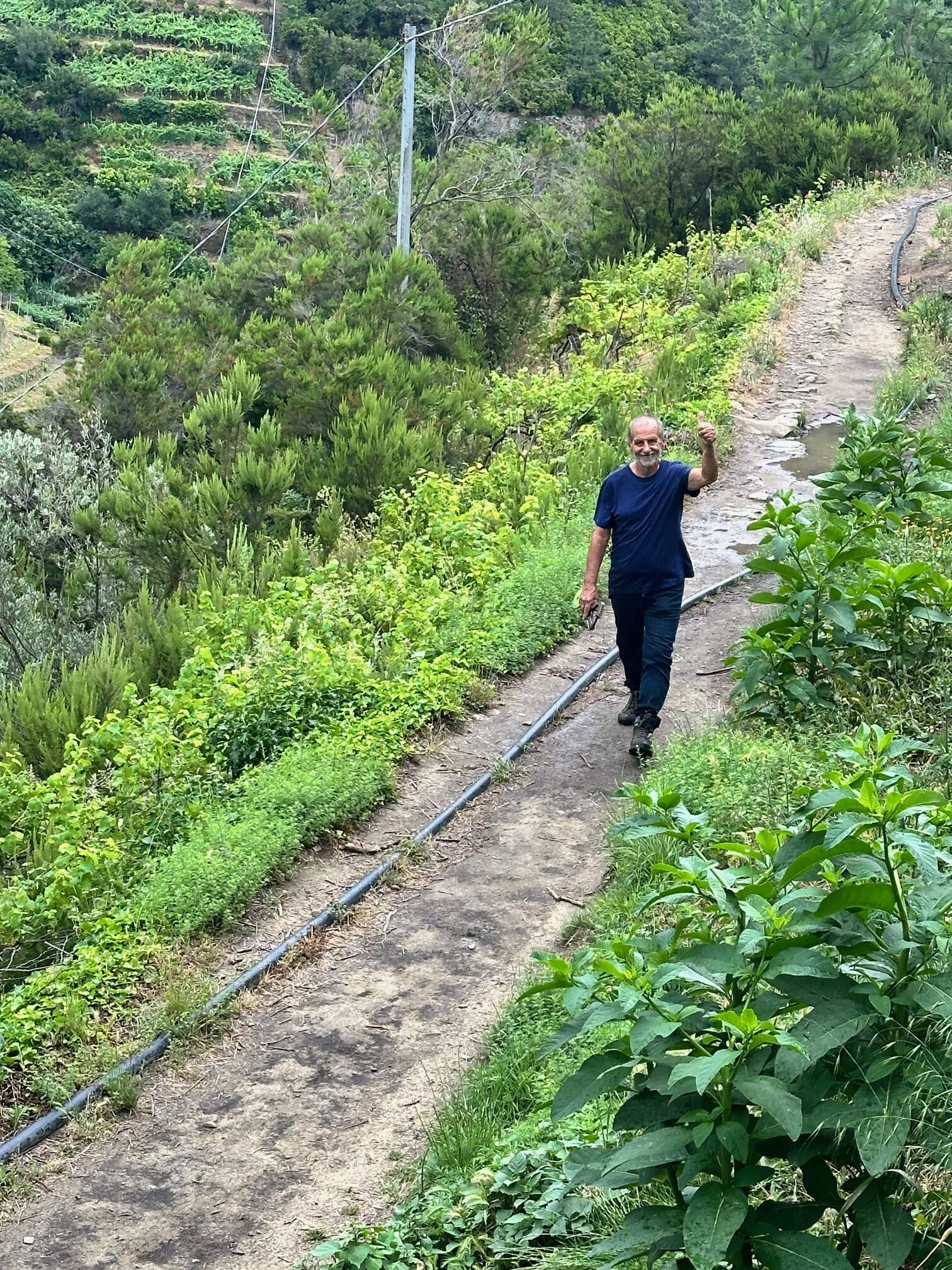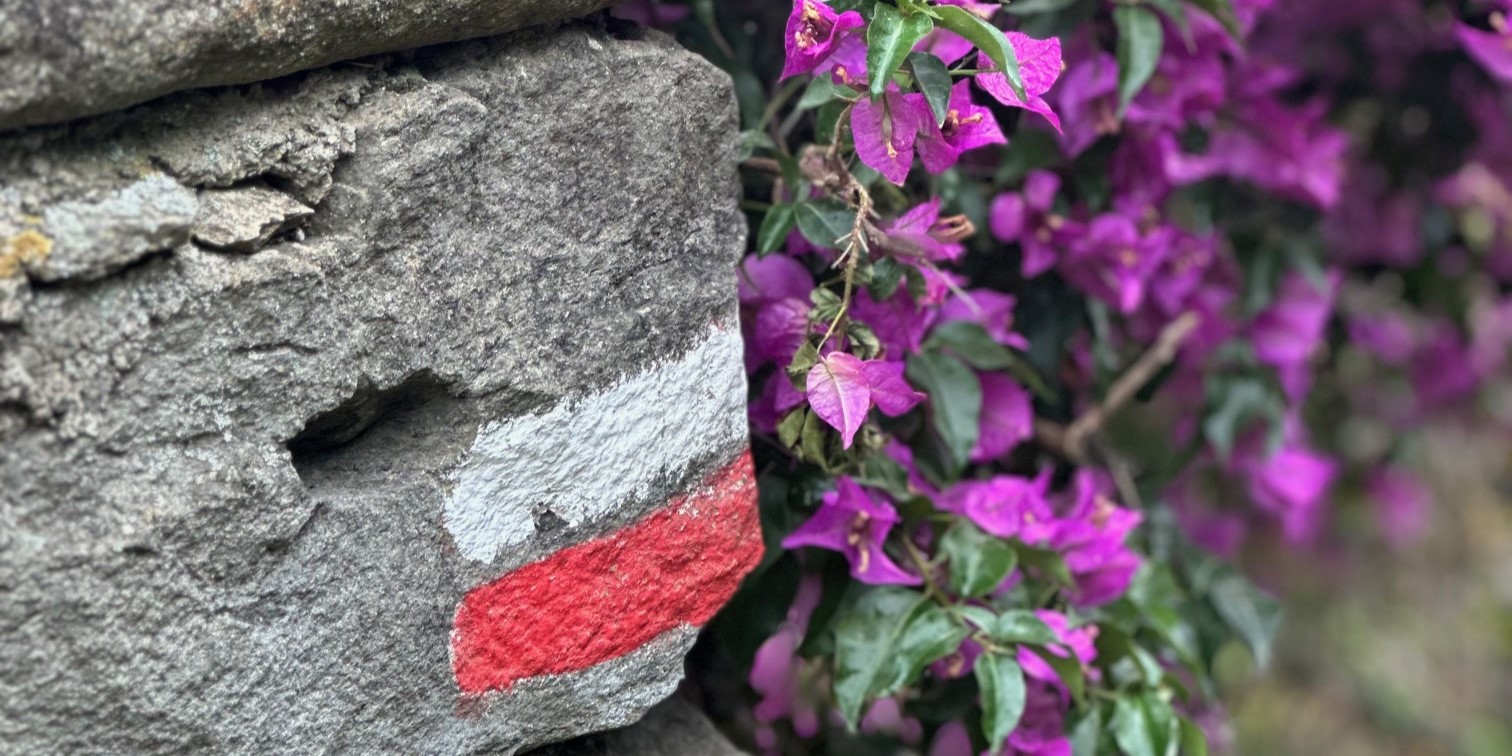
Cinque Terre means “Five Lands” in Italian. Over the centuries in these ancient fishing villages, farmers crafted terraces on the rugged, steep landscape with cliffs overlooking the Ligurian Sea. Footpaths, trains, and boats weave through the lush region, connecting the towns called Monterosso, Vernazza, Corniglia, Manarola, and Riomaggiore. These tiny settlements, together with the coastline and hills, form a national park by the same name, enjoying international legal protection for its cultural, historical and “outstanding value to humanity.”
I first read about Cinque Terre in 1997 on a train somewhere in Germany while traveling around Europe before the summer abroad program I attended in England. This was before the place was popularized by Instagram and TikTok, and the only information available were the written descriptions contained within our travel books and the mental pictures painted by fellow backpackers.
The train station at Riomaggiore was nothing special, but just like the guidebook said, Mamma Rosa was waiting outside the station. She was sitting on a four-foot stone wall which ran parallel to the tracks, her legs happily dangling toward the ground. We knew it was her because she wore a white t-shirt with the faded words “Mamma” and “Rosa” stacked one on top of the other in all caps. Her garment/name tag was draped over a red blouse with a collar, and her legs were covered by black and blue tartan plaid pants with tiny green and yellow stripes. She wore Arizona Slide Birkenstocks, a large blue fanny pack covering her belly, and red glasses with round frames nestled on her flushed cheeks. Imagine if the late Cubs broadcaster, Harry Caray, was a middle-aged Italian woman, and you have the picture.
“You-a stay-a with me-a,” Mamma Rosa called to us as we exited the train.
“Sounds great, Mamma Rosa,” my law school roommate and I replied.
Thinking that finding accommodation was a little too easy, we followed her up the steep hill away from the train station to her hostel, which was packed with flimsy bunk beds that each held the belongings of fellow backpackers.
“You-a sleep-a on the floor-a tonight, and I-a have-a bed-a for you-a tomorrow.” And she pointed to two mattresses stacked on the floor in the corner of the dining room off the small kitchen and held out her hand for payment.
After a brief conference with my traveling companion, and with no other immediately available alternatives in the steep hills of Riomaggiore, we decided the floor would be fine, so we paid her a discounted fee in Italian lira for two nights. To be honest, Mamma’s floorboards were considerably better than some of the places we had laid our heads that summer, and we were glad to have arrived. Cinque Terre quickly became one of the most beloved destinations of that trip. I have dreamed of going back for almost thirty years, and earlier this summer I did.
This time, my travel companion was my oldest daughter, Mollie Ann, and we approached the villages by train from Rapallo in route to Vernazza, where we had rented a small apartment. (Go back and read My Leather Pants and Three Australian Sisters to catch up on the blogs inspired by my latest trip to Italy)
Stepping off the train, there was no time for nostalgia, and Mamma Rosa was nowhere to be found to help us. The streets were packed with tourists, and finding our prearranged accommodation required another stop in town and multiple conversations aided by google translate, while contemporaneously juggling considerably more luggage than just a backpack.
Our room was right off the main piazza, and it had a view of the clock tower of the Church of Saint Margaret of Antioch. We could also see the town’s tiny, black-sand beach, which is protected by a stone and concrete jetty in the shape of Italy’s famous boot. We milled around the shops and seaside of Vernazza before we decided to hop on the train and travel south to my first love, Riomaggiore. Our efforts were thwarted by an angry train attendant who yelled at us in broken English that the train tickets which brought us to Cinque Terre were no longer valid. Feeling like low level criminals, we hopped off the train and straightened out our credentials before making our way back down to Mamma Rosa’s hometown.
It was different than I remembered.
The trail which hugs the coastline leading north was under construction, and the village train station, although still relatively small, had been modernized. We followed an unfamiliar pedestrian tunnel through the cliff toward the boat landing at Riomaggiore, which like the one near our rental in Vernazza, was a barrier constructed from massive boulders which protected the inlet and dozens of small, wooden fishing boats anchored in the resulting bay. We decided to make our way down to the water, where the rocks were littered with youth like seals in bathing costumes with iPhones and vapes.
I felt old and out of place.
And then I remembered –other than a postcard worthy image around every corner, my favorite thing about the Cinque Terre of my youth were my fellow backpackers. And there, spread along the rocks at the entrance of Riomaggiore by sea, were my people… thirty years ago. I took a deep breath, and the realization of three decades now history washed over me. I felt disappointed.
I was also hungry.
Unlike most of Italy, the Cinque Terre in comparison does not have amazing food. During my first trip as a poor law student, I made seafood pasta for my hostel mates with shrimp the size of lobsters marinated in olive oil and spices I had picked up in a local market. This time, our apartment did not have a kitchen, so we went to local restaurants. Apparently in Italy, one can enjoy great food or amazing views, but not both. Cinque Terre has amazing views.
***
The second day in Cinque Terre, I woke up early with the goal of hiking the entire 100-year-old trail that connects the five villages before rain was forecast to settle into the region. I headed north toward Monterosso and was able to look back upon Vernazza from the picturesque path made mostly of stone. Small vineyards, vegetable gardens, and berry vines line the trail, in addition to lemon, fig and olive trees. As I approached Monterosso, which has the biggest beach of the five towns, it began to sprinkle, but the surroundings were so beautiful, my spirit soared as the rain fell. I made the final decent into Monterosso, and stopped to read a hand painted sign welcomed me which read, “Ricordati Che Il Mare Ti Sistema L’anima.”
Remember that the sea heals your soul.
I arrived in Monterosso shortly after 7:00 a.m., just as shopkeepers were beginning preparations for the day. I found an open café, changed out of my wet clothes and ordered lots of food, water and coffee before catching the train to Mamma Rosa’s town to continue my trek. Upon my arrival, I marched straight out of town on the alternative trail to summit the large, terraced hill that separates Riomaggiore from the next village, Manarola. Out of breath from the climb, I stopped to sample green grapes within reach along the path.
They were sour.
The electric sky was pinched between the agean blue sea and the matching clouds full of rain, which were being mercifully contained for the time being. On the way down toward Manarola, there was an interesting sign in Italian. I discovered it was a memorial for Ermanno Segalini, who lived from 1949 through 2020. The tribute said, “What a job to improve the earth.” I picked a wild poppy and placed it on a loop in my backpack in his honor, secretly hoping my words and actions were also improving the earth.
The streets of Manarola were empty, but there was one open café where I fueled my mini expedition with another espresso and an apricot filled croissant. I also found a small market and bought an orange and more water, which I quickly consumed before heading up the path marked by a white and red trail sign painted on the ancient dry stacked stone wall. As I was climbing the stone stairs of the path, I came to a sign which appeared to have arrows pointing in both directions.
I went left.
Within a few minutes, the path began to disappear beneath my feet, and I found myself walking in a tiny clearing created by an irrigation system which was covered in huge thorns.
I had taken a wrong turn.
As I was about to turn around, I saw a man dressed in jeans and a t-shirt. For a moment, I thought he was a fellow explorer, but as I got closer, I realized he was a local farmer. Being a vine-grower in Cinque Terre means being part farmer, general laborer, stone mason and architect, as all these skills are needed to carve out the ancient strips of cultivable land. I was hoping to add “tour guide” to this farmer’s credentials, and I called out for help.
“Excuse me!” I yelled over the patch of vines which separated us.
“I am sorry to bother you, but I am lost. Can you help me find the trail?”
“Manarola or Corniglia?” he replied.
“Corniglia.”
The farmer gave me a knowing smile and motioned for me to follow him. He took me around his vines and down several ancient, stone staircases which connect the flat parts of the terraced ground. He picked up a vine pruning tool he had left behind along the way. When he finally touched down on the trail which I had lost, he looked at me, smiled, put his hands out like he was about to take a bow and said, “Eccolo, amico mio.” (Here it is my friend)
I responded, “Grazie mille” or “Thanks a million.” One of the few Italian phrases I know.
As I began to navigate the next set of stone steps, I looked back at my helper and gave him a thumbs up, which he returned with his left hand raised above his head along with another big smile. My dad was left-handed too, I thought. I made a mental note to remember this Italian farmer, who, like Ermanno Segalini, was making the earth better –at least for me.
I finished the entire Cinque Terre trail that day, but not before the heavens opened and soaked me from head to toe, notwithstanding the orange poncho I picked up in Corniglia. As I walked down the final flight of steps into Vernazza, I quietly celebrated the accomplishment, which had taken most of the day and trashed my inadequate footwear.
Cinque Terre does have outstanding value to humanity, but not because of its beautiful landscape, lush gardens, colorful flowers or challenging terrain. It’s the people. Like the backpackers to whom I no longer relate, and the man who balances many roles as a village farmer but made the choice to show kindness to me, a stranger. They create value for humanity, and these acts of love bind us all together -no matter what language we speak, how tall we are or the color of our skin. I was not judged for my poor choice, nor did he become angry because I was trespassing in his vineyard. With very few words, he warmly encouraged me to follow him, and I did… step by step…until I was going the right way.
Craig Robertson, the founder of Robertson + Easterling, has dedicated over 25 years to practicing high net worth divorce and complex family law in Mississippi. His approach extends beyond legal counsel, offering support to clients through the intricate and emotionally challenging journey of divorce. He provides compassionate and empathetic assistance to those navigating the path to healing.





